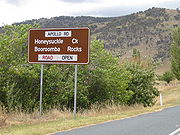
Honeysuckle Creek Tracking Station
Encyclopedia



NASA
The National Aeronautics and Space Administration is the agency of the United States government that is responsible for the nation's civilian space program and for aeronautics and aerospace research...
tracking station near Canberra
Canberra
Canberra is the capital city of Australia. With a population of over 345,000, it is Australia's largest inland city and the eighth-largest city overall. The city is located at the northern end of the Australian Capital Territory , south-west of Sydney, and north-east of Melbourne...
, Australia
Australia
Australia , officially the Commonwealth of Australia, is a country in the Southern Hemisphere comprising the mainland of the Australian continent, the island of Tasmania, and numerous smaller islands in the Indian and Pacific Oceans. It is the world's sixth-largest country by total area...
, which played an important role in supporting Project Apollo
Project Apollo
The Apollo program was the spaceflight effort carried out by the United States' National Aeronautics and Space Administration , that landed the first humans on Earth's Moon. Conceived during the Presidency of Dwight D. Eisenhower, Apollo began in earnest after President John F...
. The station was opened in 1967 and closed in 1981.
Its most noted achievement was providing the world with the first pictures of the Apollo 11
Apollo 11
In early 1969, Bill Anders accepted a job with the National Space Council effective in August 1969 and announced his retirement as an astronaut. At that point Ken Mattingly was moved from the support crew into parallel training with Anders as backup Command Module Pilot in case Apollo 11 was...
Moonwalk
Extra-vehicular activity
Extra-vehicular activity is work done by an astronaut away from the Earth, and outside of a spacecraft. The term most commonly applies to an EVA made outside a craft orbiting Earth , but also applies to an EVA made on the surface of the Moon...
on Monday, July 21, 1969. Apart from the television pictures they provided, Honeysuckle Creek and Tidbinbilla had voice and telemetry contact with the lunar and command modules. Much of this was dramatized in the 2000 Australian film The Dish
The Dish
The Dish is a 2000 Australian film that tells the story of how the Parkes Observatory was used to relay the live television of man's first steps on the moon, during the Apollo 11 mission in 1969...
.
After the conclusion of the Apollo Moon missions in 1972, Honeysuckle Creek began supporting regular Skylab
Skylab
Skylab was a space station launched and operated by NASA, the space agency of the United States. Skylab orbited the Earth from 1973 to 1979, and included a workshop, a solar observatory, and other systems. It was launched unmanned by a modified Saturn V rocket, with a mass of...
passes, the Apollo scientific stations left on the Moon
Moon
The Moon is Earth's only known natural satellite,There are a number of near-Earth asteroids including 3753 Cruithne that are co-orbital with Earth: their orbits bring them close to Earth for periods of time but then alter in the long term . These are quasi-satellites and not true moons. For more...
by astronauts, and assisting the Deep Space Network
Deep Space Network
The Deep Space Network, or DSN, is a world-wide network of large antennas and communication facilities that supports interplanetary spacecraft missions. It also performs radio and radar astronomy observations for the exploration of the solar system and the universe, and supports selected...
with interplanetary tracking commitments.
In 1974 at the conclusion of the Skylab
Skylab
Skylab was a space station launched and operated by NASA, the space agency of the United States. Skylab orbited the Earth from 1973 to 1979, and included a workshop, a solar observatory, and other systems. It was launched unmanned by a modified Saturn V rocket, with a mass of...
program, Honeysuckle Creek joined the Deep Space Network as Deep Space Station 44. Honeysuckle Creek closed in December 1981, its 26 m antenna being relocated to the Canberra Deep Space Communications Complex at nearby Tidbinbilla, and renamed Deep Space station 46, where it remained in use until late 2009.
Today the original site has been leveled, and only the concrete foundations remain. An outdoor display was added to site in 2001. The former tracking station is located at 35°35′02"S 148°58′37"E.
See also
- Apollo 11 missing tapes
- Carnarvon Tracking StationCarnarvon Tracking StationThe Carnarvon Tracking Station in Western Australia was a tracking station built in 1963 for use by NASA for the Gemini program, the second step for NASA's plan to put a human on the Moon...
- OTC Satellite Earth Station CarnarvonOTC Satellite Earth Station CarnarvonThe OTC Satellite Earth Station Carnarvon was established to meet the need for more reliable and higher quality communications for NASA's Apollo Moon project...

